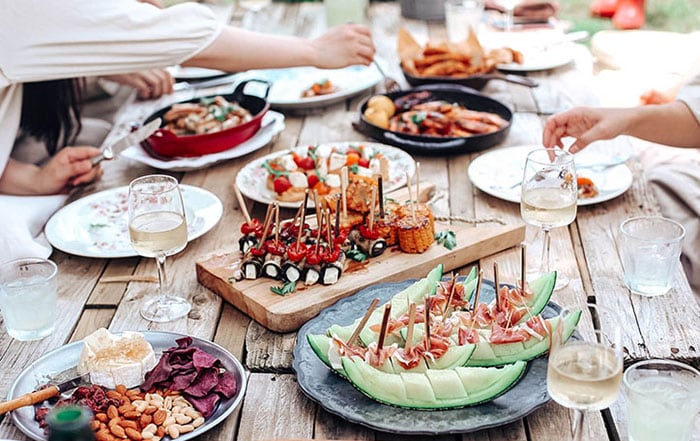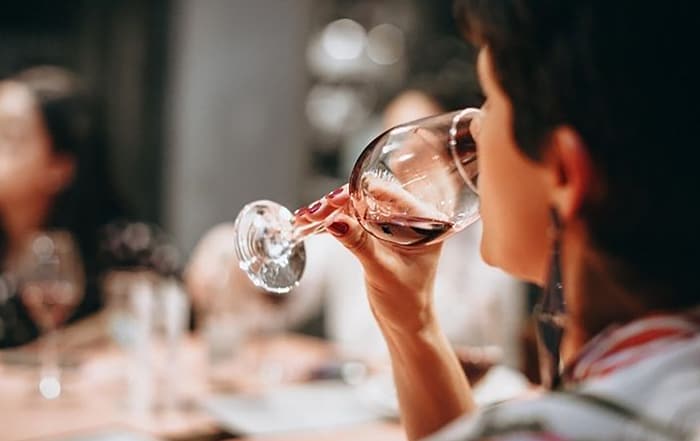However much I may appreciate the arrival of the dinner trolley on a long flight, it’s seldom for the gustatory qualities of the food and wine. If I have the exceptional pleasure of flying a long haul flight in Business Class, I might get some excitement out of the wine list. But familiar favorites seldom taste the way I am expecting them to taste.
And if I’m in economy, don’t get me started. I’ll pass on the wine and order tomato juice. The reason the wines in cattle class can be a challenge to enjoy is more complex than that the airline needs to save a few bucks. Getting a satisfying, balanced experience from the food and wine consumed at 10 000 meters is a decidedly physiological challenge.
Reduced aromas are the reason
Every wine lover knows that wine aromas are a large part of the overall wine experience. But in the airplane cabin, the exceptionally dry air (generally below 20 percent) puts your nose out of commission. The mucous membranes need to be moist in order to recognize the molecules that carry scent. In flight, they dry out and don’t allow the aromatic compounds pass like they do on the ground. Light, aromatic scents and mild, fresh fruit notes vanish into, literally, thin air. A dry, young riesling, for example, characterized by high acidity and delicate citrus notes, will lose a lot of elegance in flight and might even come off as sour.
At 10 000 meters, a significant portion of your taste buds are knocked out by the pressure changes. Everything you consume will taste notably less. Certain aromas, such as fruit notes (with the odd exception of green apple) are more affected by this than others.

Did you know that you can’t taste food or wine in the air the same way you do on the ground? There are several factors and among them, the dry air and the sound in the cabin.
Structure sticks out
With reduced taste and aroma, the wine’s structure will be more prominent. Alcohol will seem more fiery, tannins rougher, acidity higher. For this reason, some normally good wines will come off as edgy, rough, unbalanced. The sweetness of a wine is the only structural element to be reduced, along with the saltiness in your food. For this reason, a modern red wine with a touch of sweetness, like an amarone or ripasso, which at worst can be a sweet fruit bomb on the ground, can instead taste structured and elegant in the air.
To really place a nail in the coffin of your gustatory experience, the sound in the cabin has a negative effect on your food- and wine experience too. The disturbance from the background noise affects our ability to focus on the taste and scent of the food and wine, which results in less mental room to appreciate them. Yet another reason for the frequent long distance traveler to invest in high-end noise cancelling headphones.

Although the air will reduce taste and aroma, the wine’s structure can be more outstanding. Some good wines can come off as rough while a more sweet wine can instead taste structured and elegant in the air. (Photo by Ross Parmly on Unsplash)
The increased asperity of the wine has yet another reason. When you take a sip of red wine at home, the proteins in your saliva will bind the tannins in the wine, making them softer. In the dry airplane air, we produce less saliva, and the tannins appear rougher and drier without actually changing their shape. For this reason, a modern Merlot-based Bordeaux with soft, supple tannins and loads of ripe fruit notes will do well in the air while a young, traditional red Bordeaux dominated by Cabernet Sauvignon might come off as rough and sour.
Researching solutions
At the prestigious German Fraunhofer Institute, a group of researchers investigate how flavors change in flight, like the changes described above. This makes it possible for airlines and airline caterers to compensate for the changes in taste and smell, giving a better overall experience.
The best airlines include these results in their purchasing process. For the red and white alternative in economy class it might make a marginal difference but for the wine selection in the front of the plane, you might even be in for quite the wine treat.
At several five star airlines, the wine lists reflects the adaptations necessary to give a good wine experience mid-flight. The red wines selected are all rich, bold and appropriately aged, with soft ripe tannins. The whites are rather full bodied (on the ground), appearing fresh and bright on board. On the ground, the wines on the list are excellent, full bodied wines. In the air, they are elegant, more restrained, and yet retain their charm.

Tomato juice is a popular beverage when traveling. In the air, the tomato juice get a more fruity and pleasant tomato flavor than if you drink it on the ground.
In the business class of Scandinavian Airlines, the champagne is the excellent, full bodied and creamy champagne Charles Heidsieck. At 10 000 meters, it turns into a lean, mouth-watering aperitif. New flight models, such as the Airbus A350 or Boeing 787 Dreamliner are more quiet than most air planes, with optimized temperature and humidity.
Flying long-haul with one of these planes doesn’t just improve your chances of arriving fresh, but does some favor to your wine. Fly less, fly better might be my new motto. And if I can’t? Then I’m back on the tomato juice…
Why try the tomato juice:Tomato juice has always been a popular in-flight beverage, in stark contrast to the low interest for it on the ground. Frequent travelers and airplane hostesses have long wondered why this is. Among other things, they have looked into the tomato juice mystery and found a clear reason. On the ground, most tasters describe tomato juice as unpleasantly earthy and rich. At altitude, they instead describe the tomato juice as fruity, with a bright and pleasant tomato flavor. The changes to our senses from flying are not all bad! |
Read These Articles Next

How To Throw A Wine Party
Whether it was inspired from a memorable wine weekend getaway, discovering a new bottle at home with your honey, or the recent Zoom wine tasting you watched, there comes a time when you want to put your creative juices to work, invite over a few close friends and take your enjoyment of food, friends and wine to the next level. Here are a few simple ideas on how to Plan & Pull Off your next Wine Party!

In-Flight Wine: Why Airplanes Ruin Your Wine Experience
If I have the exceptional pleasure of flying a long haul flight in Business Class, I might get some excitement out of the wine list. But familiar favorites seldom taste the way I am expecting them to taste.

Tips For Creative Wine Tastings
Bored by the standard wine tasting format? Here are some tips to jazz up your enjoyment of wine and provide your guests with a night to remember. These days, wine tasting is a fully fledged leisure activity, from touring wine regions around the world to attending masterclasses and dinners – and, of course, hosting tasting events at home.

Are Wine Cabinets a Good Investment?
If you don’t have a wine cabinet or a proper underground cellar, and that store your wine at room temperature or in an area where temperatures exceed 20 degrees Celsius, your wine will be affected within a couple of months.

The benefits of buying “En Primeur”
“En Primeur” is a French wine trade term for wine which is sold as a “future”, ie. before it is bottled. En Primeur therefore also means buying wine at its very first offering price.
